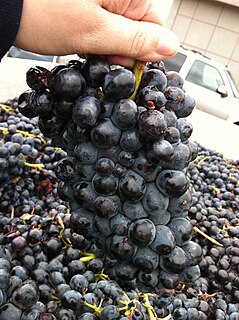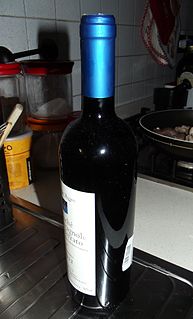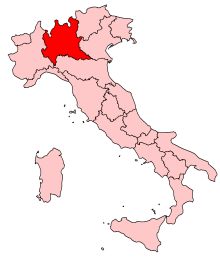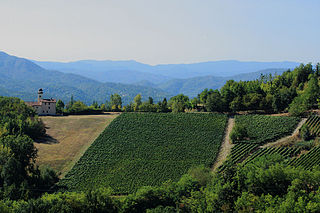
The following four classifications of wine constitute the Italian system of labelling and legally protecting Italian wine:

Barbera is a red Italian wine grape variety that, as of 2000, was the third most-planted red grape variety in Italy. It produces good yields and is known for deep color, full body, low tannins and high levels of acidity.
Grignolino is a red Italian wine grape variety commonly grown in the Piedmont region. It makes light colored wines and rosés with very fruity aromas, strong acidity and tannins. The name Grignolino derives from the word grignole which means "many pips" in the local Piedmontese dialect of the Asti region. The abundance of pips, or seeds, contributes to the strong, bitter tannins associated with the wine. Modern winemakers try to avoid the excess tannins with gentle and slow pressings. Grignolino has three Denominazione di origine controllata (DOCs) that produce wine from it - Asti, Monferrato Casale, and Piemonte Grignolino.

Asti is a sparkling white Italian wine that is produced throughout southeastern Piedmont but is particularly focused around the towns of Asti and Alba. Since 1993 the wine has been classified as a Denominazione di Origine Controllata e Garantita (DOCG) and as of 2004 was Italy's largest producing appellation. On an average vintage more than ten times as much Asti is produced in Piedmont than the more well-known Piedmontese red wine Barolo.

Costigliole d'Asti is a small Italian town in the Province of Asti, southern Piedmont. It lies about 13 kilometres south of the city of Asti in the Alto Monferrato, on the edge of the Langhe, in the alluvial plain of the river Tanaro southwards into the hills. The name derives from the Latin Corte Costeliolae.

Ruché is a red Italian wine grape variety from the Piedmont region. It is largely used in making Ruché di Castagnole Monferrato, a small production red varietal wine which was granted Denominazione di Origine Controllata (DOC) status by presidential decree on October 22, 1987, and was granted the more prestigious Denominazione di Origine Controllata e Garantita (DOCG) status in 2010. The current DOC recognized area of production for the wine covers only about 100 acres of vines around the villages of Castagnole Monferrato, Refrancore, Grana, Montemagno, Viarigi, Scurzolengo and Portacomaro. Ruché di Castagnole Monferrato is, therefore, one of the lowest production varietal wines in Italy. The grape is also grown to some extent in the neighboring province of Alessandria.
Freisa is a red Italian wine grape variety grown in the Piedmont region of north-west Italy, primarily in Monferrato and in the Langhe, but also further north in the provinces of Turin and Biella. Freisa is a vigorous and productive vine whose round, blue-black grapes are harvested in early October. The three-lobed leaves are relatively small and the bunches are elongated in form. By the 1880s it had become one of the major Piedmontese grapes, and in that period its cultivation was stimulated by the vine’s resistance to the downy mildew caused by the Plasmopara viticola fungus. Wines made from the Freisa grape are red and usually somewhat sweet and lightly sparkling, or foaming. Still and fully sparkling versions are also produced, however, as are dry and more decidedly sweet styles. In the Canavese there is also a rosé which can be made primarily from Freisa according to Denominazione di origine controllata (DOC) regulations.

Aleatico is a red Italian wine grape variety. It is notable for being the primary grape in the cult wine Aleatico di Portoferraio made in Elba. In Chile is known as Red Moscatel. The grape has also been cultivated at Mudgee in New South Wales and California.
Braquet is a red French wine grape variety grown predominantly in the Provence region of southeastern France, particularly in the Bellet Appellation d'origine contrôlée (AOC) where it is as both a blending and varietal grape in still and rosé wines. Also known as Brachet, the vine produces naturally low yields and light bodied wines that are delicately perfumed. Recent thought among ampelographers is that Braquet is not related to the more aromatic Italian wine grape of the Piedmont region known as Brachetto.

Bardolino and Bardolino Superiore are Italian red wines produced along the chain of morainic hills in the province of Verona to the east of Lake Garda. Bardolino takes its name from the town Bardolino on the shores of Lake Garda and was awarded Denominazione di origine controllata (DOC) status in 1968. The Superiore is a stronger aged wine, and was promoted to Denominazione di origine controllata e garantita (DOCG) status in 2001. The blend of grapes used to produce the wine primarily includes Corvina, Rondinella, and Molinara. Up to 15% of the blend is allowed to include Rossignola, Barbera, Sangiovese, or Garganega, in any combination.
Cortese is a white Italian wine grape variety predominantly grown in the southeastern regions of Piedmont in the provinces of Alessandria and Asti. It is the primary grape of the Denominazione di origine controllata (DOC) wines of Cortese dell'Alto Monferrato and Colli Tortonesi as well as the Denominazione di Origine Controllata e Garantita (DOCG) wine of Cortese di Gavi. Significant plantings of Cortese can also be found in the Lombardy region of Oltrepò Pavese and in the DOC white blends of the Veneto wine region of Bianco di Custoza. Cortese has a long history in Italian viticulture with written documentation naming the grape among the plantings in a Piedmontese vineyard as early as 1659. The grape's moderate acidity and light flavors has made it a favorite for the restaurants in nearby Genoa as a wine pairing with the local seafood caught off the Ligurian coast.
Gattinara is a red Italian wine with Denominazione di Origine Controllata e Garantita (DOCG) status produced from Nebbiolo grapes grown within the boundaries of the comune of Gattinara which is located in the hills in the north of the province of Vercelli, northwest of Novara in the Piedmont region. It was awarded DOC status in 1967 and received its DOCG classification in 1990.

Taurasi and Taurasi riserva are red, still Italian wines based principally on the Aglianico grape variety produced in the Province of Avellino in the Campania region. They were awarded Denominazione di Origine Controllata (DOC) status in 1970 and Denominazione di Origine Controllata e Garantita (DOCG) status in 1993. Produced less than 40 miles (64 km) from the other Aglianico stronghold of Aglianico del Vulture in Basilicata, the volcanic soils of the Taurasi region demonstrate the potential the Aglianico grape has to make wines on par with the Nebbiolo grape of Piedmont and Sangiovese grape of Tuscany. The popularity of the region's wine is a relatively recent phenomenon. Until the early 1990s, there was only one winery (Mastroberardino), producing wine for the export market. By the mid-2000s, there were over 293 producers in the Taurausi zone.

Malvasia di Castelnuovo Don Bosco is a sweet, sparkling, red or rosé DOC dessert wine produced in the Italian province of Asti from the Malvasia di Schierano grape variety with the optional addition of up to 15% Freisa.

Piemonte wine is the range of Italian wines made in the region of Piedmont in the northwestern corner of Italy. The best-known wines from the region include Barolo and Barbaresco. They are made from the Nebbiolo grape. These wines are ideal for storage and a well-aged Barolo for instance may leave a feeling of drinking velvet because the tannins are polished and integrated more and more into the wine. As the wine matures the colour becomes more brownish and rust-red.

Lombardia (Lombardy) wine is the Italian wine produced in the Lombardy region of north central Italy. The region is known particularly for its sparkling wines made in the Franciacorta and Oltrepò Pavese areas. Lombardy also produces still red, white and rosé wines made from a variety of local and international grapes, including Nebbiolo wines in the Valtellina region and Trebbiano di Lugana white wines produced with the Chiaretto style rosé along the shores of Lake Garda. The wine region currently has 15 Denominazione di origine controllata (DOC), 3 Denominazione di Origine Controllata e Garantita (DOCG) and 13 Indicazione Geografica Tipica (IGT) designations. The main cities of the region are Milan, Bergamo and Brescia. The region annually produces around 1.3 million hectolitres of wine, more than the regions of Friuli-Venezia Giulia, Marche, Trentino-Alto Adige/Südtirol and Umbria.
Uva Rara is a red Italian wine grape variety that is grown in the Piedmont and Lombardy wine regions of northern Italy. The grape is a permitted blending variety along with Nebbiolo in the Denominazione di Origine Controllata e Garantita (DOCG) wines of Ghemme. In the Denominazione di Origine Controllata (DOC) wine region of Oltrepò Pavese the grape is often blended with Barbera and Croatina. While Uva Rara's name means "rare grape" in Italian, the variety is actually widely planted with 608 hectares of the vine recorded in Italy in 2000.
Brugnola is a red Italian wine grape variety that is grown in the Lombardy wine region of Valtellina. While historically, Brugnola was thought to be a local synonym for Emilia-Romagna wine grape Fortana, DNA analysis has shown that the two grapes are distinct variety and that, instead, Brugnola shares a close genetic relationship with the Piedmont wine grape Nebbiolo.

Brachetto d'Acqui is a red Italian wine that is classified as a Denominazione di Origine Controllata e Garantita (DOCG) since 1996 and previously a Denominazione di Origine Controllata (DOC) region since 1969. It is produced in the Piedmont wine region around Acqui Terme in the province of Alessandria with some overlap into the province of Asti. The wine is produced from the Brachetto grape, a variety that is believed to be native to Piedmont, and can be still or sparkling with usually some sweetness.












